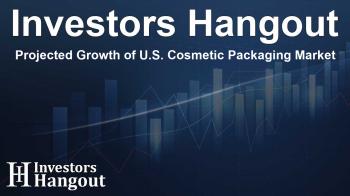Projected Growth of U.S. Cosmetic Packaging Market

Introduction to the U.S. Cosmetic Packaging Market
The U.S. cosmetic packaging market is witnessing remarkable growth, with its revenue projected to reach USD 3.27 billion within a decade. This upward trend is driven by various factors, including advancements in sustainable packaging solutions, the expansion of the beauty sector, and evolving consumer preferences. Recent research indicates that the market had a strong revenue starting point of USD 2.1 billion and is set for substantial increases in the coming years.
Key Drivers of Market Growth
Several elements contribute to the impressive expansion of the cosmetic packaging industry in the U.S. Firstly, the booming beauty sector, including skincare, makeup, and haircare, significantly impacts packaging demand. As consumers seek innovative formats like refillable products, manufacturers have recognized the necessity of adopting modern packaging solutions. Notably, major brands are heavily investing in sustainable materials that resonate with eco-conscious consumers, reinforcing the importance of responsible packaging practices.
Consumer Demand for Sustainability
Today's consumers are increasingly inclined towards brands committed to sustainability. The growing awareness surrounding environmental issues has encouraged cosmetic businesses to adopt eco-friendly packaging solutions. This shift not only enhances brand loyalty but also opens doors to consumers looking for environmentally responsible options. Packaging made from biodegradable materials is gaining traction, aligning with the broader movement towards sustainability.
Innovative Packaging Solutions
Modern packaging innovations, such as airless pumps and refillable jars, are now essential in the beauty industry. These innovations not only cater to functional needs but also improve user experience. Consumers appreciate packaging that offers convenience and maintains product integrity. Additionally, the integration of smart packaging, features like QR codes, is becoming popular, providing consumers with greater interaction and information about the products.
Challenges Facing the Industry
Despite its rapid growth, the U.S. cosmetic packaging market faces several challenges. One of the primary concerns is adherence to sustainability standards. Stricter regulations can delay product launches and increase costs associated with compliance. Manufacturers must invest in advanced technologies and innovative practices to overcome these hurdles and continue to thrive in a competitive landscape.
Market Segmentation Insights
The cosmetic packaging market can be segmented based on various criteria, including packaging type, material, and product category. Currently, bottles and jars dominate the market due to their versatility and consumer preference for premium aesthetics. Tubes are projected to experience faster growth owing to their convenience and multifunctional use in multiple cosmetic products.
Recent Market Trends
In the current landscape, there are several notable trends in the U.S. cosmetic packaging market. The shift towards refillable options has positively impacted profitability and growth. This trend appeals especially to younger consumers, who prioritize sustainability and innovative design. Furthermore, the demand for sleek and minimalist design continues to grow, impacting the scalability of businesses within the industry.
Distribution Channels
The dominant distribution channel remains offline retailing, where consumers prefer to engage with products directly. Popular beauty retailers and department stores allow consumers to examine the quality of packaging, influencing their purchasing decision significantly. However, the rise of e-commerce has propelled brands to make their packaging more attractive to capture online sales effectively.
Conclusion and Market Outlook
In summary, the U.S. cosmetic packaging market is poised for substantial growth, driven by increasing demand for sustainable practices, innovative solutions, and a booming beauty industry. Brands that adapt to these shifts and prioritize consumer preferences will continue to thrive. As the market adapts and evolves, staying informed about the latest trends and consumer behaviors will be crucial for industry players looking to capitalize on this booming market.
Frequently Asked Questions
What is the expected growth rate of the U.S. cosmetic packaging market?
The U.S. cosmetic packaging market is projected to grow from USD 2.1 billion to USD 3.27 billion by the mid-2030s.
What factors drive demand in this market?
Key drivers include expanding beauty sectors, innovative packaging solutions, and increasing consumer preference for sustainable packaging.
Which packaging formats are currently popular?
Bottles, jars, and tubes are among the most popular formats due to their versatility and consumer appeal.
How does sustainability impact the cosmetic packaging industry?
Sustainability is increasingly prioritized, pushing brands to adopt eco-friendly materials and practices, enhancing their appeal to market-conscious consumers.
What challenges does the cosmetic packaging market face?
Challenges include adhering to stricter sustainability standards, which can impact product costs and timelines.
About The Author
Contact Evelyn Baker privately here. Or send an email with ATTN: Evelyn Baker as the subject to contact@investorshangout.com.
About Investors Hangout
Investors Hangout is a leading online stock forum for financial discussion and learning, offering a wide range of free tools and resources. It draws in traders of all levels, who exchange market knowledge, investigate trading tactics, and keep an eye on industry developments in real time. Featuring financial articles, stock message boards, quotes, charts, company profiles, and live news updates. Through cooperative learning and a wealth of informational resources, it helps users from novices creating their first portfolios to experts honing their techniques. Join Investors Hangout today: https://investorshangout.com/
The content of this article is based on factual, publicly available information and does not represent legal, financial, or investment advice. Investors Hangout does not offer financial advice, and the author is not a licensed financial advisor. Consult a qualified advisor before making any financial or investment decisions based on this article. This article should not be considered advice to purchase, sell, or hold any securities or other investments. If any of the material provided here is inaccurate, please contact us for corrections.

